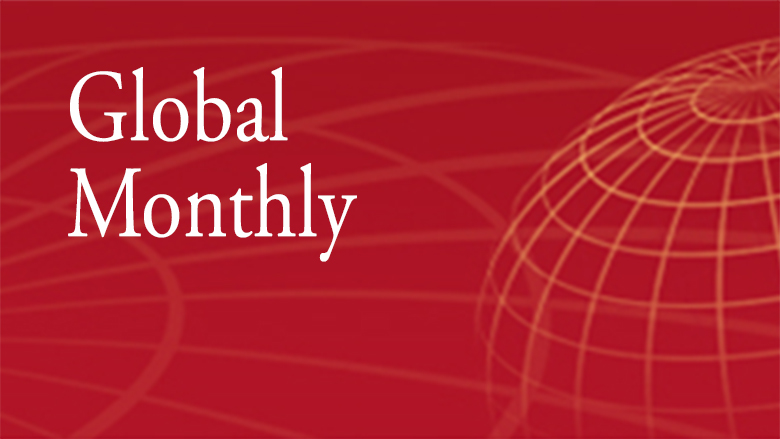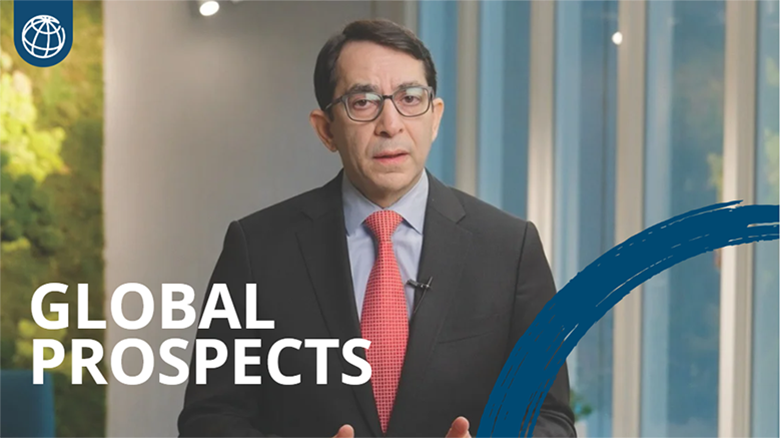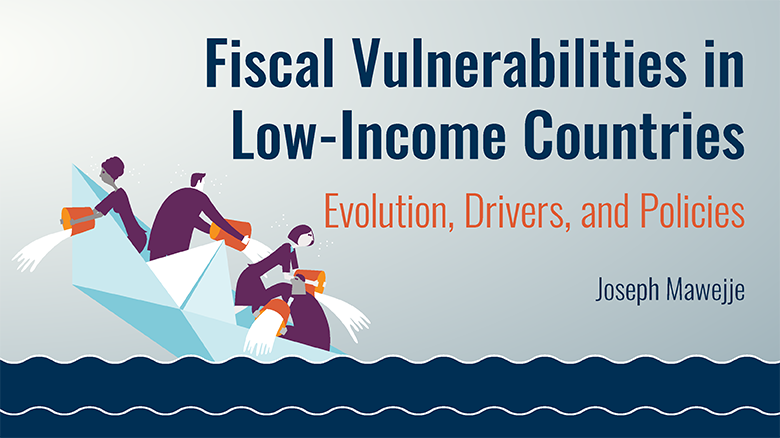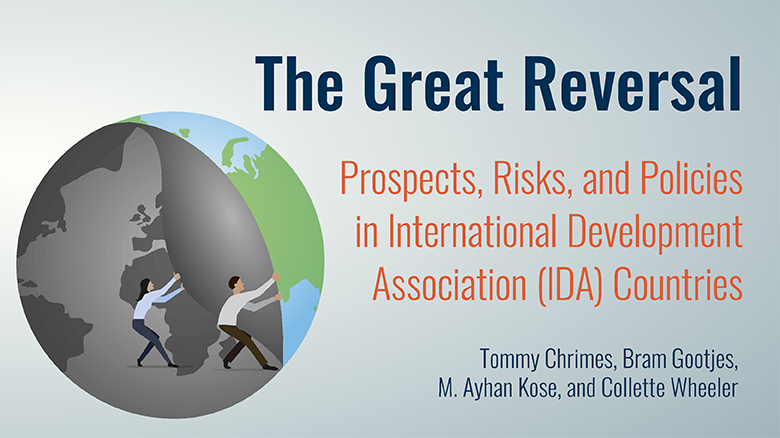
Global Economic Prospects
Emerging and Developing Economies in the 21st Century
Global growth is expected to hold steady at 2.7 percent in 2025-26. However, the global economy appears to be settling at a low growth rate that will be insufficient to foster sustained economic development. Emerging market and developing economies are set to enter the second quarter of the 21st century with per capita incomes on a trajectory that implies feeble catch-up toward those of advanced economies. Most low-income countries are not on course to graduate to middle-income status by 2050. Policy action at the global and national levels is needed to foster a more favorable external environment, enhance macroeconomic stability, reduce structural constraints, address the effects of climate change, and thus accelerate long-term growth and development.
-
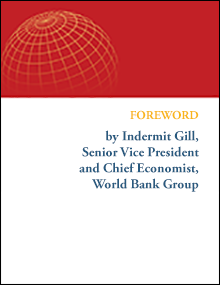 Introduction from the Chief Economist
Introduction from the Chief EconomistAs the first quarter of the century winds to a close, it’s clear that the lofty development goals of the past few decades will not be met, says World Bank Group Chief Economist and Senior Vice President Indermit Gill in his Foreword. Developing economies now face fierce headwinds: weak investment and productivity growth, aging populations in many of the poorest countries, rising geopolitical tensions, and the mounting dangers of climate change. They “should have no illusions about the struggle ahead,” he writes. “The next 25 years will be a tougher slog than the last 25. A fresh game plan is needed—one that strengthens their capacity to fend for themselves and seize growth opportunities wherever they can be found.”
Global and Regional Outlooks
-
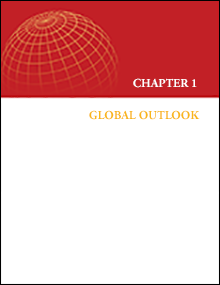 Global
GlobalGlobal growth is stabilizing as inflation returns closer to targets and monetary easing supports activity. This should give rise to a moderate global expansion of 2.7 percent in 2025-26. However, growth prospects appear insufficient to offset the damage done by several years of negative shocks. Heightened policy uncertainty and adverse trade policy shifts represent key downside risks. Other risks include escalating geopolitical tensions, higher inflation, and more extreme weather events. Decisive policy action is needed to safeguard trade, address debt vulnerabilities, combat climate change, pursue price stability, boost revenues and rationalize expenditures, lift human capital, and bolster labor force inclusion.
-
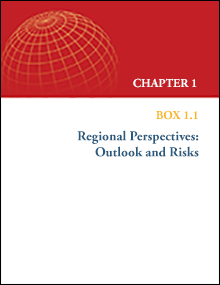 Regional Perspectives: Outlook and Risks
Regional Perspectives: Outlook and RisksEmerging market and developing economy regions face varying growth prospects this year. Growth is projected to moderate in East Asia and Pacific and in Europe and Central Asia, reflecting decelerations in some large economies. In contrast, a pickup is anticipated in Latin America and the Caribbean, the Middle East and North Africa, South Asia, and Sub-Saharan Africa, supported by robust domestic demand. In 2026, growth is expected to strengthen in most regions. Risks to the outlook remain tilted to the downside, centering on adverse shifts in global trade policies. Escalating conflict, slower growth in major economies, higher inflation and attendant slower monetary policy easing, and climate-related natural disasters pose additional downside risks.
-
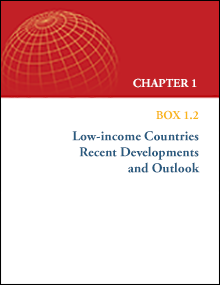 Low-income Countries: Recent Developments and Outlook
Low-income Countries: Recent Developments and OutlookThe number of people struggling with extreme poverty in low-income countries (LICs) remains high. Recent flare-ups of violent conflict, increased debt-service costs, and reduced fiscal policy space pose challenges for many LICs. Growth in LICs is now estimated at 3.6 percent for 2024 and forecast to average 5.8 percent in 2025-26—mainly driven by improvements in the outlook for some fragile and conflict-affected LICs. Risks to the outlook are tilted to the downside. They include intensifying insecurity and violent conflict, lower global growth, more persistent inflation, increased risk of government debt distress, and more frequent or intense extreme weather events.
-
 East Asia and Pacific
East Asia and PacificGrowth in the East Asia and Pacific region is projected to slow to 4.6 percent in 2025 and 4.1 percent in 2026, down from an estimated 4.9 percent in 2024, reflecting a further deceleration in China. In China, growth is expected to decline from 4.9 percent in 2024 to 4.5 percent in 2025 and 4.0 percent in 2026, amid broad-based weakness in domestic demand. Elsewhere in the region, growth is projected to edge up to 4.9 percent in 2025 before settling at 4.7 percent in 2026, anchored by solid domestic demand. Risks to the outlook remain tilted to the downside and center on adverse global policy shifts, particularly relating to trade policies, and a sharper slowdown in China. Further downside risks include spillovers from an intensification of conflict, notably in the Middle East, and climate-change-related natural disasters. Prospects for U.S. growth, global inflation, and monetary policies remain uncertain and present both upside and downside risks to the region.
-
 Europe and Central Asia
Europe and Central AsiaGrowth in Europe and Central Asia is projected to moderate to 2.5 percent this year before picking up to 2.7 percent in 2026. The slowdown in 2025 primarily reflects softer activity in the Russian Federation and Türkiye. Excluding these economies and Ukraine, growth is forecast to strengthen to an average of 3.3 percent in 2025-26. Private consumption and investment are expected to be the main growth drivers amid less restrictive monetary policies and easing inflationary pressures. A key downside risk to the outlook is the potential for heightened global policy uncertainty and adverse trade policy shifts, which could weigh on trade, capital flows, and growth prospects across the region. Other risks include escalating geopolitical tensions, particularly those related to Russia’s invasion of Ukraine, and higher-than-expected regional inflation.
-
 Latin America and the Caribbean
Latin America and the CaribbeanGrowth in Latin America and the Caribbean is forecast to increase from 2.2 percent last year to an average of 2.5 percent in 2025-26. This improvement is partly driven by Argentina’s expected recovery following two consecutive years of contraction. Most central banks in LAC are anticipated to resume interest rate cuts in 2025 after pausing in the second half of 2024 due to renewed price pressures. A projected softening in commodity prices is expected to weigh on growth only moderately in a few countries. Risks to the outlook remain tilted to the downside. Heightened policy uncertainty and adverse trade policy shifts in the United States could negatively affect the region’s exports. A tightening of global financial conditions would raise debtservicing costs and could prompt faster fiscal consolidation across the region. A sharper-than-expected weakening of growth in China could adversely affect the region’s exports. Climate-change-related extreme weather events pose an additional key risk.
-
 Middle East and North Africa
Middle East and North AfricaGrowth in the Middle East and North Africa region is expected to pick up from an estimated 1.8 percent in 2024 to 3.4 percent in 2025 and 4.1 percent in 2026. &e outlook for this year has deteriorated since June, primarily due to extended oil production cuts by major oil producers. &e major downside risks to the outlook are the intensification of armed conflicts in the region, heightened policy uncertainty, and unexpected adverse global policy shifts. Delays in oil production hikes by major oil exporters could also slow regional growth. Other downside risks include persistent global inflation and a resulting tightening of global financial conditions, heightened domestic violence and social tensions, and more frequent extreme weather events. Upside risks to the outlook include the possibility of stronger growth in major economies and easier global financial conditions due to faster-than-expected disinflation.
-
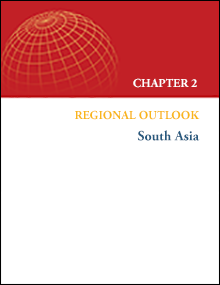 South Asia
South AsiaGrowth in South Asia is expected to remain high over the forecast period, averaging 6.2 percent in 2025-26, with the high level driven by resilient activity in India. Aggregate growth in the rest of the region is also projected to firm to 4.2 percent a year, on average, in 2025-26, with activity picking up in many countries. Risks to the outlook are tilted to the downside. Major downside risks include heightened policy uncertainty and adverse trade policy shifts in major trading partners, as well as higher commodity prices. Other downside risks include heightened domestic violence and social unrest, a slower pace of monetary easing and larger debt-service burdens, more frequent extreme weather events, and slower-than-projected growth in major global economies. An upside risk is stronger-than-expected growth in major economies, which would increase global demand and economic activity in the region.
-
 Sub-Saharan Africa
Sub-Saharan AfricaGrowth in Sub-Saharan Africa is projected to strengthen to an average of 4.2 percent in 2025-26, driven primarily by improvements in the outlook for industrial-commodity-exporting countries, including the region’s largest economies. However, high government debt and elevated interest rates have narrowed fiscal space, prompting fiscal consolidation efforts in many countries, while financing needs remain high. Despite the projected pickup in growth, per capita income gains will remain inadequate to make significant progress in reducing extreme poverty in the region. Risks to the outlook remain tilted to the downside. These risks include weaker global growth due to heightened uncertainty and the potential for adverse changes in trade policies; a sharper-than-expected slowdown in China; increased regional or global instability, such as an escalation of conflicts in Sudan and in the Middle East, which could drive up energy and food price inflation in the region; increased risk of government distress amid a possibility of higher-for-longer global interest rates; and greater frequency and intensity of adverse weather events.
Two Current Issues
-
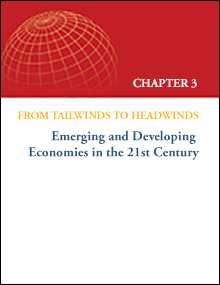 From Tailwinds to Headwinds: Emerging and Developing Economies in the 21st Century
From Tailwinds to Headwinds: Emerging and Developing Economies in the 21st CenturyThe 21st century has been transformative for emerging market and developing economies. These economies now account for about 45 percent of global GDP, up from 25 percent in 2000, powered by global trade and financial integration. Interdependence among EMDEs has also increased, fostering substantial growth spillovers from the largest EMDEs—China, India, and Brazil—and the emergence of an EMDE business cycle. Yet EMDEs face daunting headwinds. Protectionist measures and geopolitical fragmentation complicate the external environment. Climate-related disasters are more frequent and costly. Fiscal constraints have intensified. To accelerate growth and development, EMDEs should implement policies that accelerate investment and productivity, cope with difficult external conditions, and enhance macroeconomic stability.
-
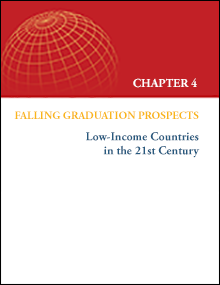 Falling Graduation Prospects: Low-Income Countries in the 21st Century
Falling Graduation Prospects: Low-Income Countries in the 21st CenturyRapid growth, underpinned by domestic reforms and a benign global environment, allowed many low-income countries (LICs) to attain middle-income status early in the twenty-first century. Prospects for today’s LICs are more challenging—amid heightened conflict, advancing climate change, and other adverse global trends, the vast majority are not on track to become middle-income by 2050. To kick-start stronger growth, today’s LICs can leverage growing populations, natural resource endowments, and regional trade integration. However, harnessing these factors hinges on increasing investment, closing gender gaps, addressing fiscal risks, and attaining greater peace and stability. Enhanced international support will also be needed, backed by deep knowledge of country circumstances.
Downloads
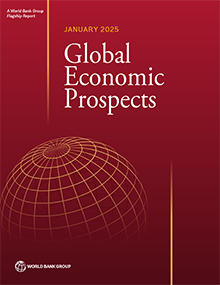
- Full report (PDF)
- All charts and data (Zip)
- Presentation (PPT)
- Press releases:
- June 2024 (3.7 MB)
- January 2024 (4.6 MB)
- June 2023 (4.6 MB)
- Jan. 2023 (3.2 MB)
- June 2022 (3.2 MB)
- Jan. 2022 (12.3 MB)
- June 2021 (3.7 MB)
- Jan. 2021 (9.1 MB)
- June 2020 (12.8 MB)
- Jan. 2020 (3.7 MB)
- June 2019 (3.7 MB)
- Jan. 2019 (4.0 MB)
- June 2018 (4.2 MB)
- Jan. 2018 (4.2 MB)
- June 2017 (3.8 MB)
- Jan. 2017 (5.9 MB)
- June 2016 (3.9 MB)
- June 2024
- January 2024
- June 2023
- January 2023
- June 2022
- January 2022
- June 2021
- January 2021
- June 2020
- January 2020
- June 2019
- January 2019
- June 2018
- January 2018
- June 2017
- January 2017
- June 2016
- January 2016
- June 2015
- January 2015
- June 2014
- January 2014
- June 2013
- January 2013
- June 2012
- January 2012
- June 2011
- January 2011
- June 2010
- January 2010
- 2009
- 2008
- 2007
- 2006
- 2005
- 2004
- 2003
- 2002

